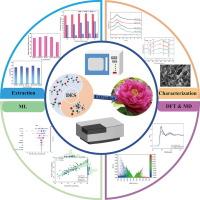分子模拟和机器学习辅助探索甜菜碱为基础的深共晶溶剂萃取牡丹花瓣中活性物质
IF 9
1区 工程技术
Q1 ENGINEERING, CHEMICAL
引用次数: 0
摘要
采用微波辅助深共晶溶剂萃取法(MAE-DES)提取牡丹花瓣中有效成分。采用四种不同组分的DES作为提取溶剂,以总酚含量(TPC)、总黄酮含量(TFC)和总花青素含量(TAC)评价其提取效果。采用响应面法(RSM)对反应温度、反应时间和液固比进行优化。结果表明,在优化条件下,TPC、TFC和TAC的提取率分别为321.59 mg GAE/g、61.65 mg RE/g和2.15 mg C3GE/g。固体残留物表征表明,DES有效地破坏了牡丹花瓣的结构。此外,通过机器学习(ML)研究了影响提取效率的变量的重要性。最后,通过密度泛函理论(DFT)和分子动力学(MD)模拟,探讨了DES对活性化合物的萃取机理。结果表明,活性化合物的提取效率受到与DES氢键相互作用的影响,本研究为活性化合物的提取提供了多种方法和见解的高效提取方案和机理研究。本文章由计算机程序翻译,如有差异,请以英文原文为准。


Molecular simulation and machine learning assisted in exploring betaine-based deep eutectic solvent extraction of active compounds from peony petals
Microwave-assisted deep eutectic solvent extraction (MAE-DES) method was proposed to extract of active compounds from peony petals. Four different components of DES were used as extraction solvent, and the extraction effect was evaluated by total phenolic content (TPC), total flavonoid content (TFC) and total anthocyanin content (TAC). Response surface methodology (RSM) was used to optimize the reaction temperature, reaction time and liquid–solid ratio. The results showed that under optimized conditions, the extraction yields of TPC, TFC and TAC were 321.59 mg GAE/g, 61.65 mg RE/g and 2.15 mg C3GE/g, respectively. The characterization of solid residue showed that DES effectively disrupted the structure of peony petals. In addition, the importance of variables affecting extraction efficiency was investigated by machine learning (ML). Finally, the extraction mechanism of DES for active compounds was explored by density functional theory (DFT) and molecular dynamics (MD) simulation. The results showed that the extraction efficiency of active compounds was affected by the hydrogen bond interaction with DES. This study provides efficient extraction protocol and mechanism research for the extraction of active compounds from multiple methods and insights.
求助全文
通过发布文献求助,成功后即可免费获取论文全文。
去求助
来源期刊

Separation and Purification Technology
工程技术-工程:化工
CiteScore
14.00
自引率
12.80%
发文量
2347
审稿时长
43 days
期刊介绍:
Separation and Purification Technology is a premier journal committed to sharing innovative methods for separation and purification in chemical and environmental engineering, encompassing both homogeneous solutions and heterogeneous mixtures. Our scope includes the separation and/or purification of liquids, vapors, and gases, as well as carbon capture and separation techniques. However, it's important to note that methods solely intended for analytical purposes are not within the scope of the journal. Additionally, disciplines such as soil science, polymer science, and metallurgy fall outside the purview of Separation and Purification Technology. Join us in advancing the field of separation and purification methods for sustainable solutions in chemical and environmental engineering.
 求助内容:
求助内容: 应助结果提醒方式:
应助结果提醒方式:


